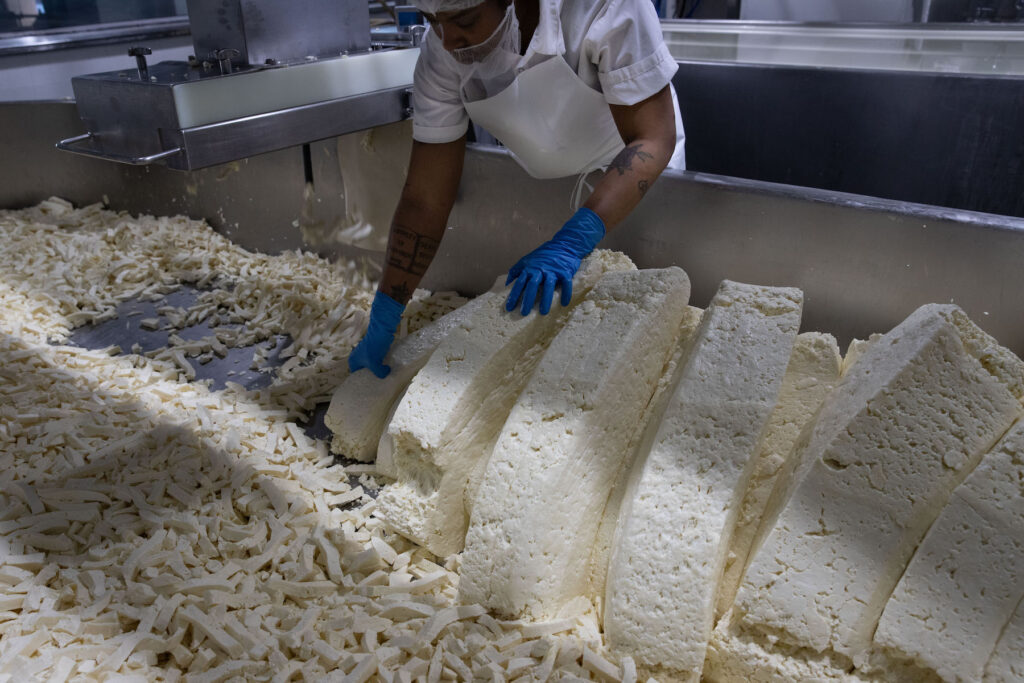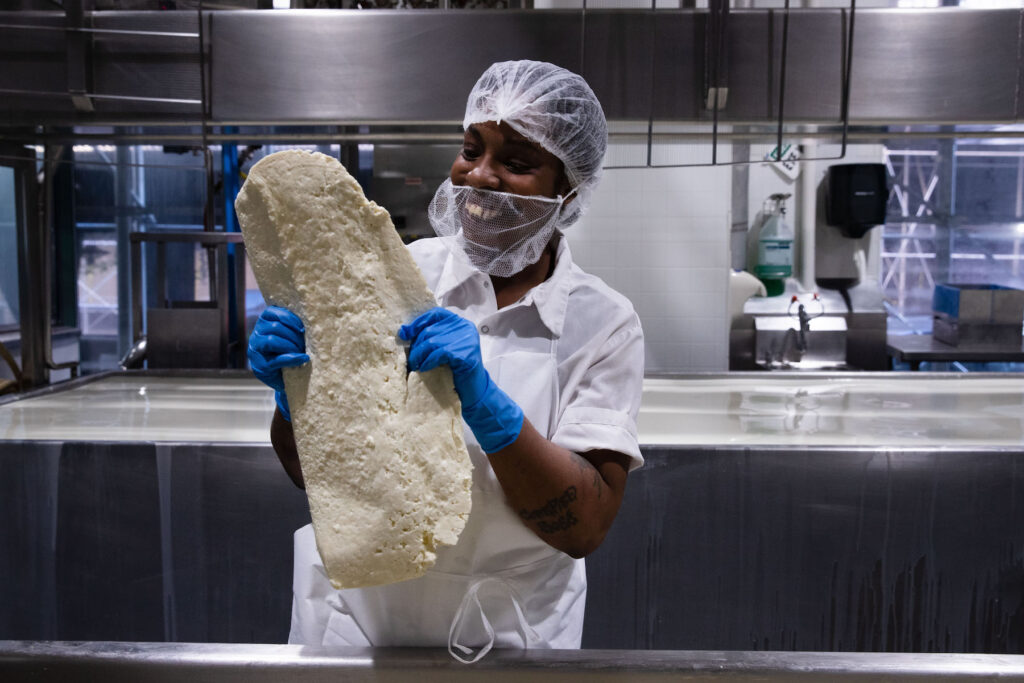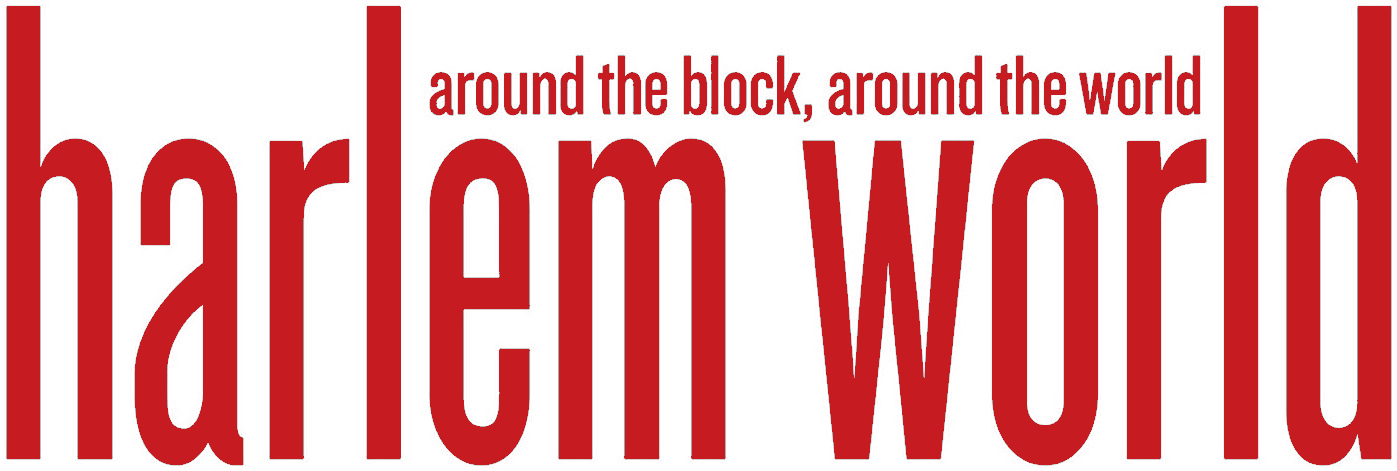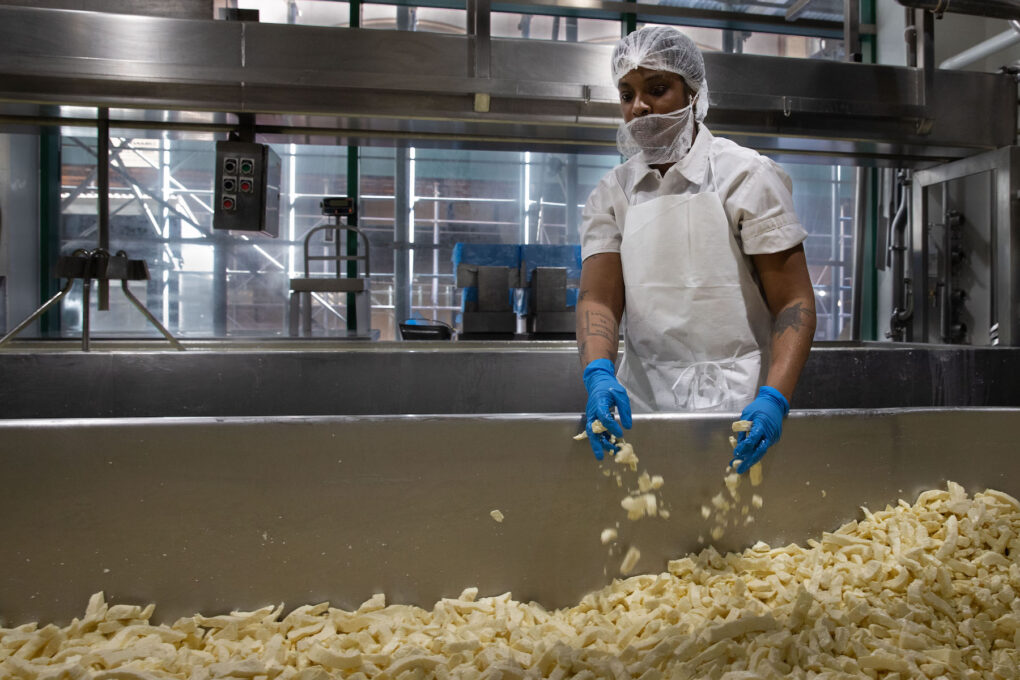
Just 30 minutes from Harlem, Twentieth street is nearly deserted when Fame Toney approaches Beecher’s Handmade Cheese at 1:55 am on a Saturday morning in May.
The milk truck driver clambers down from the cab where he’s been napping to meet Fame at the side entrance. Most mornings he waits more than an hour, built-in time in case something happens to the truck carrying precious cargo–55,000 pounds of raw milk–down from two farms in the Hudson Valley. By the evening that milk will have transformed into more than 5,000 pounds of cheddar cheese.
Fame fills a stainless steel cart with everything needed for the day: packets of freeze-dried culture in a little cooler, a gallon bottle of bacterial rennet, and the production clipboard stuffed with the necessary paperwork for a day of cheesemaking.
He sets up the room, unearths pipes from the tank called the COP (clean out of place) where they were washed the previous night, and completes the jigsaw-like line that pumps milk through the pasteurizer and across the room to the make-vat and then up and over to its neighboring drain table where the cheese is made.
The pasteurizer revs up with deafening clunks and bangs. Once the temperature stabilizes, milk flows through a clean white filter sock at the end of a pipe to fill the vat for the first of four batches that day. Lots of work needs to be done around the room as the milk level rises before it’s time to add culture, and shortly thereafter, rennet. Another cheesemaker joins Fame on the floor and, when Fame has time he helps with the hoop-breaking.
The two of them pull the blocks of cheddar made the day before from the rows of hydraulic presses where excess whey was squeezed out overnight. They thump the hoops – metal boxes that shape the 40-pound blocks –against the stainless steel table so the cheeses pop out. They unwrap the blue cheesecloth, called poly webbing, and vacuum seal them in plastic bags to protect them for the year and a half of aging ahead.

Fame has been making cheese at Beecher’s since 2018. He stumbled upon cheesemaking while searching for a second job on Indeed to supplement his work at the Fairway Cafe in Brooklyn. “It was a lot of the click to apply so when they emailed me I was kind of confused, like, what interview is this?” He started out working 2 pm to midnight so he could stay on at Fairway, but as his son, Bryson, got older he needed to be around in the afternoons.
He realized he wanted to transition as a teenager during an internship at Harvey Milk Hetrick-Martin, but didn’t want to jeopardize his relationship with his mother. After she passed away in his mid-30s, and he’d had time to grieve, he started taking steps to medically transition and came out at work. It took a while for his fellow cheesemakers to adapt to his new name and pronouns, but now that he’s been there over four years, he’s considered an OG which garners respect.
It takes a long time to get good at all the different tasks necessary for the job. Besides the actual cheesemaking, you also need to know the procedures for the many cleaning chemicals that are used in particular orders and dilutions to avoid contamination or injury, how all the pipes fit together, what to do in case of a raw milk leak, and how to handle if ConEd shuts off the steam, or if the elevator, vacuum sealer, or curd mill breaks down. Plus you’re expected to be able to manage the work of two if someone calls out.
By 4:30 am, three more cheesemakers have arrived. Cheesemaking is a group effort, and most tasks for the rest of the day require multiple sets of hands working together. Once the rennet coagulates the milk, two cheesemakers take harps–large metal frames strung with wires–which they pull through the Greek yogurt-like curd first one way, then the other, then across, to create small cubes of curd that float in the translucent yellow whey.
They cook the curd before pumping it from the vat to the drain table. Fame and a fellow cheesemaker use hoes to pull curd away from the drain in the middle, creating two long piles of curd on either side. The curd knits together as it rests to become solid hills. These are then cut into manageable loaves, flipped, and stacked so that the weight of the upper loaves pressed out the whey from the lower loaves. In 15-minute intervals, they are flipped and restacked so all the curd is evenly pressed. This is the cheddaring process and produces the particular cheddar texture that sets it apart from other cheeses. In the background, the vat is filled with freshly pasteurized milk for the second batch of the day.
When the pH of the curd drops to the perfect level of acidity, Fame feeds the loaves into the mill, which cuts them into finger-sized pieces. These are colloquially called squeakers for the sound they make against your teeth when you bite them. They are the curds famous for being deep fried in Wisconsin or tossed with french fries and gravy in Canada.

Once all the loaves are milled, Fame spreads a bucket of salt across the table of curds and he and his fellow cheesemakers mix it in using large blue shovels. They then load up the hoops with salted curd, weigh them to just under 60 pounds, and lug them over to the clean hydraulic presses.
This is just the first of four batches that day, other cheesemakers arrive for the night shift and work till midnight.
Read the entire article at Edible Manhattan.
Photos credit: 1-3) By H Conley.






